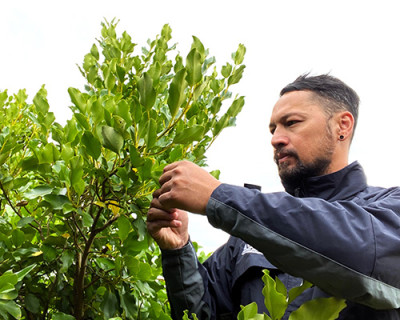"Seeing how happy everyone was knowing that their whenua and river is safe guarded for future generations, I can fully understand it."
- Tahauriki Paki, Catchment Management Officer

Tahauriki Paki says being a catchment management officer is a way to give back to the Waikato River.
For Tahauriki Paki, an internship as a restoration officer on Waikato Regional Council’s Ngā Wai o Waikato catchment restoration project was a way to give back to the Waikato River.
A carpenter by trade, the father of two says he applied for the internship offered to Waikato-Tainui tribal members because he had grown up swimming in the Waikato River and he wanted the same for his kids and their kids – and all future generations.
"I have lived my life on the Waikato River, in Ngāruawahia and Huntly," says Tahauriki. "The job was a good way to give back to my family, my iwi, my whanau."

Over the three years, 114 kilometres of fencing was completed.
The three-year $7.21 million Ngā Wai o Waikato project saw Waikato Regional Council work with eligible landowners to undertake retirement of steep hill country, afforestation, pole planting, riparian fencing and planting, and actions to reduce and prevent stream bank erosion in the lower Waikato River catchments. It was funded $3.52 million from the Climate Resilience COVID-19 Response and Recovery Fund administered by Kānoa, Regional Economic Development and Investment, and $1.35 million by Waikato River Authority.
The catchments for targeted work, identified in the Waikato and Waipā River Restoration Strategy as priorities for restoration, were lakes Waikare, Waahi and Whangape and the Whangamarino and Opuatia wetlands.

Planting in the Opuatia wetland area.
The project provided the equivalent of 36 fulltime positions to local nurseries, fencers, planters and weed contractors.
Over the three years, 114 kilometres of fencing was completed, 640 hectares of land retired, 515,000 plants planted into erosion prone sites, and 144 river erosion control structures – predominantly vegetation or rock groynes – were erected. The area of land retired was five times the project’s target, such was the landowner interest.
Tahauriki, who now works fulltime as a catchment management officer for Waikato Regional Council, says his role was to engage with landowners to retire areas of their property at no cost to them, to help improve water quality.
"The landowners understand the environmental benefits, and the funding in place took the burden of cost off them," says Tahauriki.
"I worked a lot with whanau affiliated to Waikato-Tainui and I loved it – I loved talking to whanau, understanding the background of the whenua, understanding their stories, and everyone had stories to tell."

Pole planting on steep hill country.
One story of his own includes working with an elderly landowner, who really advocated to his whanau the kaupapa of Ngā Wai o Waikao, but who has since passed away.
"He was passionate, and he really got through to the whanau over the land. The land block had multiple landowners, was held in a trust, and included both sides of the Mangatangi River. It took a year for him to get everyone on board. We had multiple hui."
"It looks beautiful now – a lot of fencing and planting; a lot of native plants."
"There were definitely tears, being able to see the river again. The kuia and kaumatua hadn’t seen the swimming holes for so long because of all the willows and pest plants. Seeing how happy everyone was knowing that their whenua and river is safe guarded for future generations, I can fully understand it."
The Ngā Wai o Waikato restoration project will now continue at a smaller scale, co-funded by the regional council, Waikato River Authority, the Ministry for Primary Industries’ MPI Hill Country Erosion Fund and catchment landowners.



To ask for help or report a problem, contact us
Tell us how we can improve the information on this page. (optional)